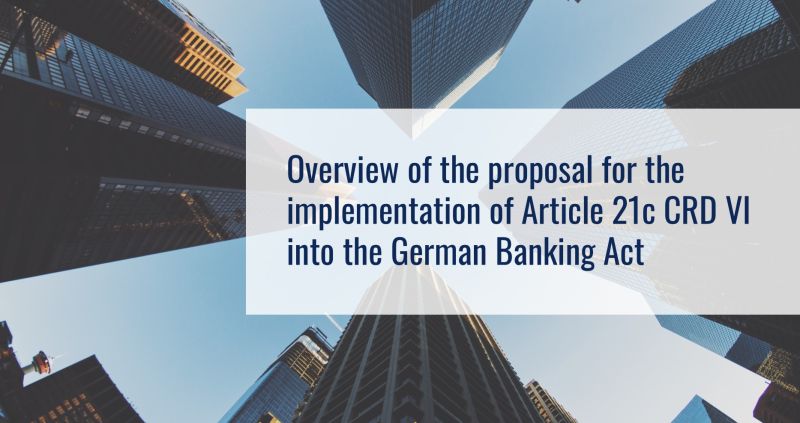CRD6 Article 21c and Third Country Banks: The introduction of Article 21c of the Capital Requirements Directive (CRD6) marks a significant regulatory shift for third country banks seeking to operate within the European Union (EU). Set to take full effect on January 11, 2027, this new rule imposes stricter conditions for non-EU financial institutions providing “core banking services” in EU Member States. This development has far-reaching implications for the global financial sector, particularly in how third country banks structure their EU operations.
What is Article 21c of CRD6?
Article 21c, introduced as part of the sixth Capital Requirements Directive (CRD6), mandates that any third country undertaking aiming to offer core banking services in an EU Member State must now establish a regulated branch within the EU—referred to as a “third country branch” (TCB). Without this regulated presence, third country banks will be prohibited from providing such services, unless they qualify for a specific exemption.
This rule is designed to bolster the regulatory framework across the EU, ensuring higher levels of transparency, accountability, and financial stability by subjecting third country branches to direct EU supervision.
Dates and Deadlines
- Transposition Deadline: EU Member States must incorporate the Article 21c requirement into their national legislation by January 10, 2026.
- Effective Date: The rule will take effect from January 11, 2027.
- Grandfathering Provision: Contracts signed before July 11, 2026 are protected under acquired rights, exempt from the new branch requirement.
These transitional provisions are crucial for firms planning their compliance roadmap, allowing a reasonable preparation window while avoiding disruption to existing operations.
Read about: Motilal Oswal Initiates Coverage on Bajaj Housing Finance: 3 Key Drivers to Watch
Impact on Third Country Banks and International Finance Sector
Heightened Regulatory Obligations
Third country banks now face the obligation to establish fully regulated EU branches if they want to continue delivering core banking services, including deposit-taking, lending, payment services, and more. The TCB will be subject to local supervisory authorities, capital requirements, reporting obligations, and governance standards under the CRD framework.
Challenges for Global Institutions
For non-EU banks, this means significant restructuring efforts:
- Establishing local legal entities in key EU Member States.
- Adjusting compliance frameworks to align with EU prudential standards.
- Navigating local regulatory transpositions that may vary by jurisdiction.
These adjustments will require careful planning to avoid business disruptions, particularly for institutions with widespread cross-border activities in Europe.
Emerging Issues and Considerations
- Exemption Criteria
Some exemptions may apply under limited circumstances, such as if the third country is recognized as having equivalent regulatory standards. However, these are subject to ongoing interpretation by national authorities, and firms are advised to evaluate eligibility in advance. - Grandfathering Implications
Existing contracts signed before the cutoff date of July 11, 2026, will benefit from grandfathering provisions. It is critical for firms to review their portfolios and finalize contracts before this deadline to preserve operational continuity. - Transposition Tracker
Given that individual EU Member States will have flexibility in implementing the directive into national law, variation in local interpretations and additional rules may arise. Firms are advised to use a transposition tracker to monitor developments in relevant jurisdictions.

Suggested Next Steps for Potentially Affected Firms
- Conduct a gap analysis to assess current structures against the new Article 21c requirements.
- Plan to establish a regulated third country branch (TCB) well ahead of the January 2027 deadline.
- Evaluate existing contracts for eligibility under the grandfathering provision.
- Monitor local transposition progress closely using reliable tools like a transposition tracker.
- Engage regulatory experts or legal counsel to navigate jurisdiction-specific nuances.
CMS is actively supporting clients through the implementation of CRD6, offering tailored guidance and practical solutions for achieving compliance.
Also read: Chery Tiggo 8 Review: A Budget-Friendly Seven-Seat SUV Challenging the Market
Conclusion: Preparing for Article 21c of CRD6
Article 21c of CRD6 represents a major evolution in the regulatory environment for third country banks operating in the EU. By requiring a regulated EU branch to provide core banking services, the directive ensures better oversight and alignment with EU prudential standards.
Firms should begin implementing structured compliance strategies today to avoid last-minute disruptions. With the grandfathering window closing on July 11, 2026, and the transposition deadline of January 10, 2026, planning has never been more critical.
For international financial institutions, this development is not just a compliance hurdle—it is an opportunity to demonstrate operational resilience, regulatory commitment, and long-term strategic planning.
FAQ – CRD6 Article 21c and Third Country Banks
1. What does Article 21c of CRD6 require?
Article 21c mandates that third country banks providing core banking services in the EU must establish a regulated third country branch (TCB) in an EU Member State, unless an exemption applies. This ensures that such banks are subject to EU supervisory oversight.
2. When will the new rule take effect?
The new third country branch requirement must be transposed into national laws by January 10, 2026, and will become effective from January 11, 2027. Contracts signed before July 11, 2026 will benefit from grandfathering protections.
3. What are the potential challenges for third country banks?
Third country banks will face challenges including:
- Setting up local regulated branches.
- Adapting governance, capital, and reporting frameworks to meet EU standards.
- Navigating varying transpositions by different EU Member States.
4. Are there any exemptions under Article 21c?
Exemptions are limited and generally apply only if the third country has equivalent regulatory regimes recognized by the EU. However, these are subject to interpretation and national implementation, so careful legal assessment is advised.
5. How can firms prepare for the CRD6 changes?
Firms should:
- Perform a thorough gap analysis.
- Finalize eligible contracts before the grandfathering cutoff.
- Engage legal and regulatory experts.
- Monitor transposition progress using a reliable tracker.
- Plan and establish a compliant third country branch early.

kjrpg0